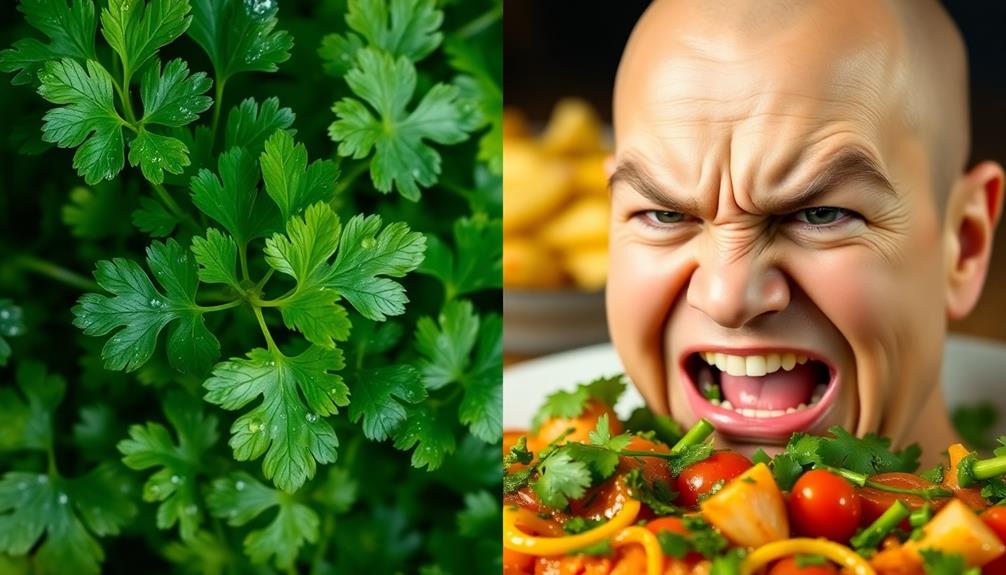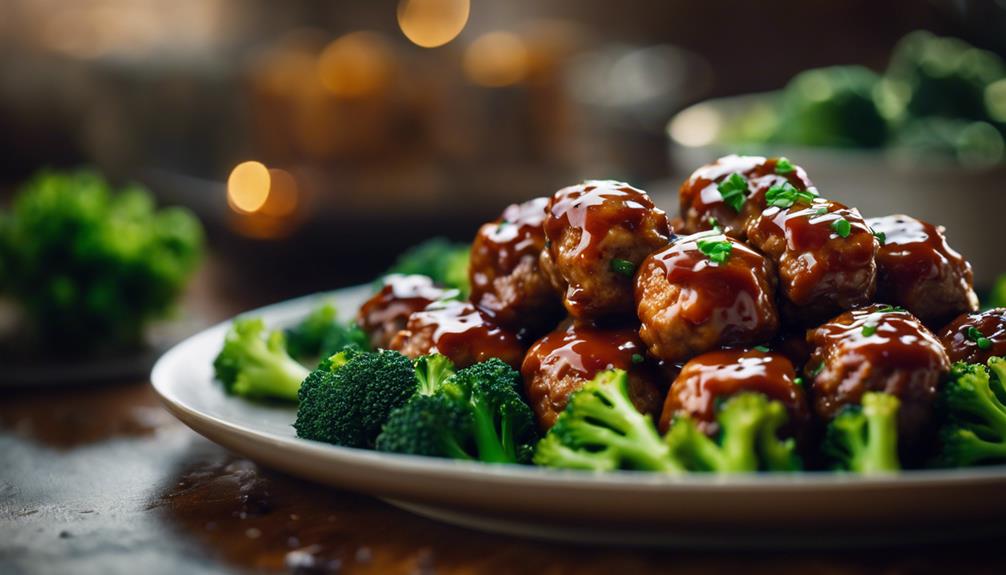Some people love cilantro while others hate it due to a mix of genetics and cultural influences. Your perception of cilantro's flavor is greatly shaped by genetic variations, particularly the OR6A2 gene, which can make it taste soapy to about 10% of the population. Additionally, your cultural background plays a key role; in regions where cilantro is a staple, it's often embraced. Conversely, in cultures where it's less common, aversions are more frequent. This complex interplay between genetics and culture makes cilantro a polarizing herb. If you're curious about more factors influencing your taste preferences, there's a lot more to explore.
Key Takeaways
- Cilantro flavor perception varies due to genetic differences, particularly linked to the OR6A2 gene affecting sensitivity to its aldehydes.
- Approximately 10% of the population experiences a strong aversion to cilantro, often describing it as soapy.
- Cultural backgrounds play a significant role, with regions that commonly use cilantro showing higher acceptance and enjoyment.
- Repeated exposure and culinary practices can help individuals reduce their dislike for cilantro over time.
- Psychological factors, including past experiences and social influences, can shape one's perception and appreciation of cilantro.
Cilantro Overview
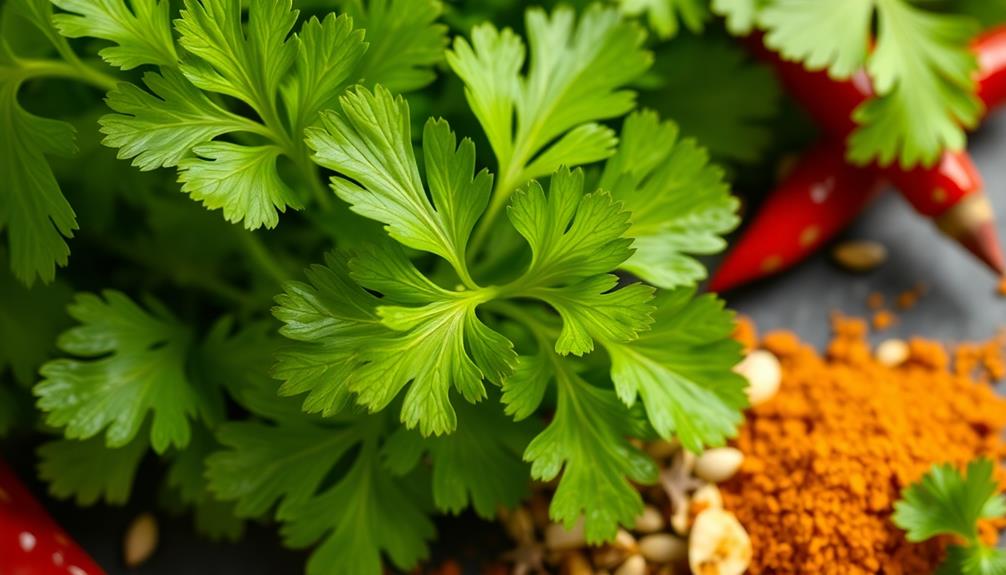
Cilantro, also known as coriander, is a vibrant herb that many people love or hate. This leafy green is widely used in cuisines around the world, especially in Central America, India, and the Mediterranean. Its flavor is often described as a mix of parsley and citrus, making it a favorite in dishes like Tex-Mex salsa and various Indian recipes, such as Mushroom Masala and Chicken Chettinad.
However, not everyone shares this enthusiasm. For some, cilantro evokes a strong cilantro dislike, often described as tasting soapy or unpleasant. This aversion isn't just a matter of personal preference; it's linked to genetic variations that affect how certain people perceive flavors. The aroma of cilantro is tied to specific aldehydes, which can trigger these polarizing responses.
Interestingly, the prevalence of cilantro dislike varies geographically. In places where cilantro is a culinary staple, fewer individuals report an aversion. In contrast, nearly 20% of East Asians express a dislike for the herb.
Understanding these differences can shed light on why cilantro remains a contentious ingredient, sparking debates among food lovers and skeptics alike.
Genetic Influences on Taste
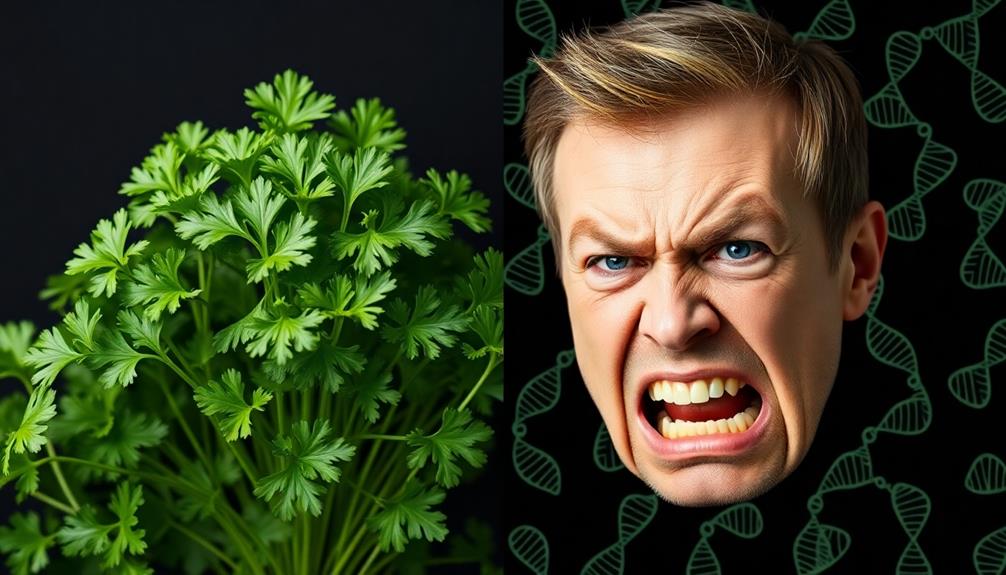
The way you perceive cilantro's flavor can be considerably influenced by your genetics. Specific olfactory-receptor genes, particularly OR6A2, play a key role in how you detect the soapy-flavored aldehydes in cilantro. For about 10% of the population, heightened sensitivity to these compounds results in a strong aversion to its taste. If you belong to this group, you might find cilantro unpalatable.
Notably, studies show that women are more likely than men to describe cilantro as having a soapy taste, suggesting a genetic predisposition that affects taste perception. Additionally, certain cuisines, such as Sichuan Cold Noodles, may highlight the contrast in flavors that cilantro brings, further influencing individual preferences.
Moreover, ethnic differences in cilantro aversion are quite pronounced. Nearly 20% of East Asians report disliking cilantro, while lower percentages are noted among South Asians, Latinos, and Middle Eastern individuals.
Twin studies reinforce the genetic basis for these preferences, revealing that identical twins tend to share cilantro likes and dislikes more than fraternal twins.
Cilantro Aversion Statistics
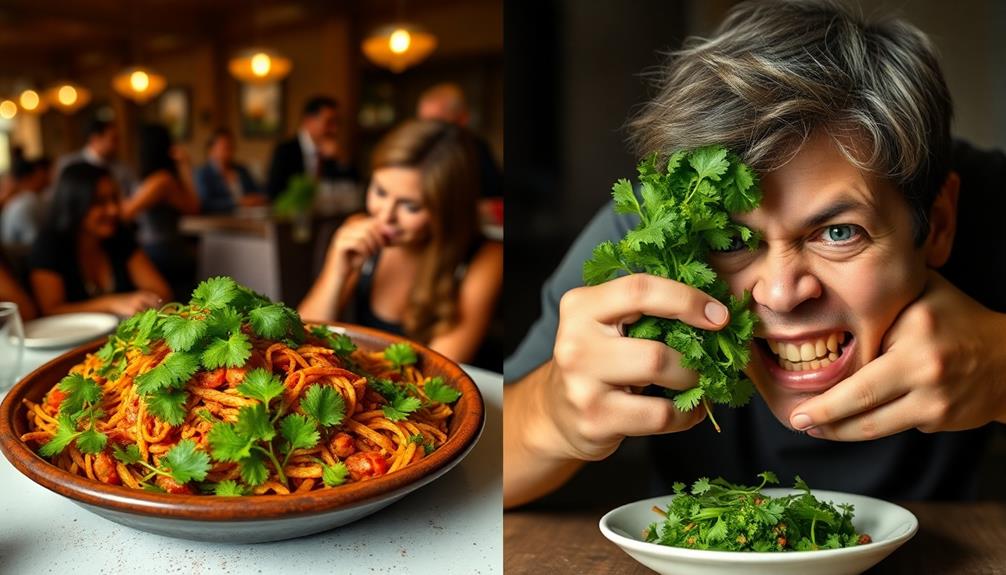
You might be surprised to learn that cilantro aversion affects 4% to 14% of the population, with significant differences depending on ethnicity.
For instance, nearly 21% of East Asians dislike cilantro, while only 3% of South Asians and Latin Americans share that sentiment. This variation is partly attributed to genetic factors, particularly the OR6A2 gene, which influences how you perceive cilantro's taste.
Curiously, just as taste preferences vary among populations, diverse culinary traditions like Ugali and Sukuma Wiki in Kenya showcase how cultural backgrounds can influence food appreciation.
Genetic Influences on Perception
Curiously, genetic variation greatly influences how people perceive cilantro, with about 10% of individuals experiencing an intense aversion due to heightened sensitivity to its aldehydes, which they describe as soapy. The OR6A2 gene plays a significant role in detecting those chemical compounds, shaping your personal taste preferences. Twin studies show that identical twins are more likely to share cilantro preferences compared to fraternal twins, reinforcing the genetic component in cilantro aversion.
Here's a quick overview of cilantro aversion statistics:
| Group | Aversion Percentage | Notable Gene Influence |
|---|---|---|
| Overall Population | 10% | OR6A2 |
| East Asians | 20% | Chromosome 11 |
| South Asians | 3% | Chromosome 11 |
| Latin Americans | 3% | Chromosome 11 |
| Identical Twins Preference | Higher | Genetic Similarity |
This data highlights how genetic factors shape your perception of cilantro, leading to this divisive taste experience. Understanding these influences helps explain why some of you love cilantro while others can't stand it.
Ethnic Group Discrepancies
Cilantro aversion varies considerably across different ethnic groups, revealing intriguing cultural and genetic influences. In Brazilian cuisine, for example, cilantro is often used to enhance the flavors of dishes like Caldeirada, showcasing its acceptance in various regional culinary traditions.
If you're curious about who tends to dislike this herb, statistics provide some eye-opening insights. Approximately 21% of East Asians report a dislike for cilantro, making them the group with the highest incidence of aversion. In contrast, around 17% of individuals of European descent express similar feelings, showing a notable difference in preference compared to other ethnicities.
When you look at South Asians, Latin Americans, and Middle Eastern individuals, the numbers drop dramatically. Only about 3% of these groups share cilantro aversion, reflecting a broader cultural acceptance of the herb in their cuisines.
Overall, ethnic group discrepancies in cilantro aversion highlight that roughly 4% to 14% of the general population may dislike the herb, with variations largely tied to genetic predisposition.
Research indicates that specific genetic factors, such as the OR6A2 gene, contribute to these differing rates of aversion among ethnic backgrounds.
Cultural Perspectives on Cilantro
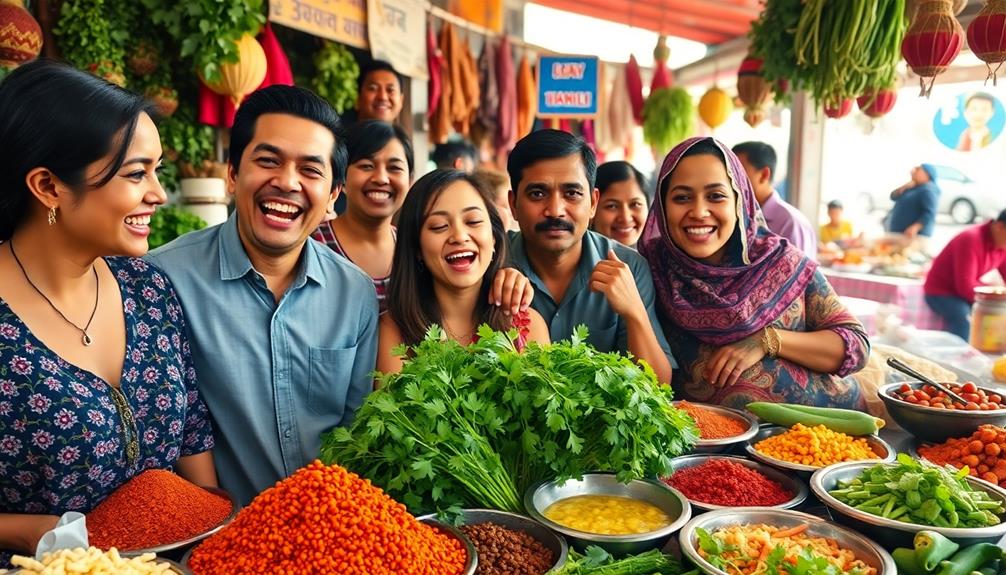
Cultural perspectives shape how people experience cilantro, often dividing opinion between those who cherish its vibrant flavor and those who can't stand it. In many regions, particularly in Central America, India, and the Mediterranean, cilantro is a staple herb celebrated for enhancing dishes.
For instance, in Lebanese cuisine, herbs like cilantro play an essential role in enriching the flavors of traditional meals like Kawarma. If you come from a culture where cilantro is commonly used, you're likely to have a lower aversion to its taste compared to others.
Interestingly, ethnic groups demonstrate different levels of cilantro acceptance. For instance, nearly 21% of East Asians report disliking cilantro, while only 3% of South Asians and Latin Americans share that sentiment. This discrepancy highlights how cultural familiarity influences individual preferences.
The more you're exposed to cilantro in shared meals, the more likely you're to appreciate its unique flavor. Discussions about cilantro preferences can reveal cultural biases as well. If you're accustomed to specific cuisines that heavily feature cilantro, you might find it much easier to embrace its taste than others who aren't familiar with it.
Ultimately, your culinary background plays a significant role in shaping your cilantro experience, either fostering love or aversion.
Overcoming Cilantro Dislike

For those who struggle with a dislike for cilantro, there are effective strategies to help you overcome that aversion. Start by exposing yourself to the cilantro plant in small amounts. Gradually incorporating it into your meals can help reduce your dislike through familiarity. You might also try crushing cilantro leaves before using them; this can lessen that infamous soapy taste.
Another approach is to enjoy cilantro in dishes rich with complementary flavors. Positive experiences with cilantro in a flavorful dish can shift your perception over time. Experimenting with different preparations can also lead to new discoveries. Here's a quick guide to help you:
| Strategy | Description |
|---|---|
| Repeated Exposure | Gradually add cilantro to your meals. |
| Crushing Leaves | Crush before use to reduce the harsh taste. |
| Complementary Dishes | Pair with other strong flavors to mask aversion. |
Cilantro's Health Benefits
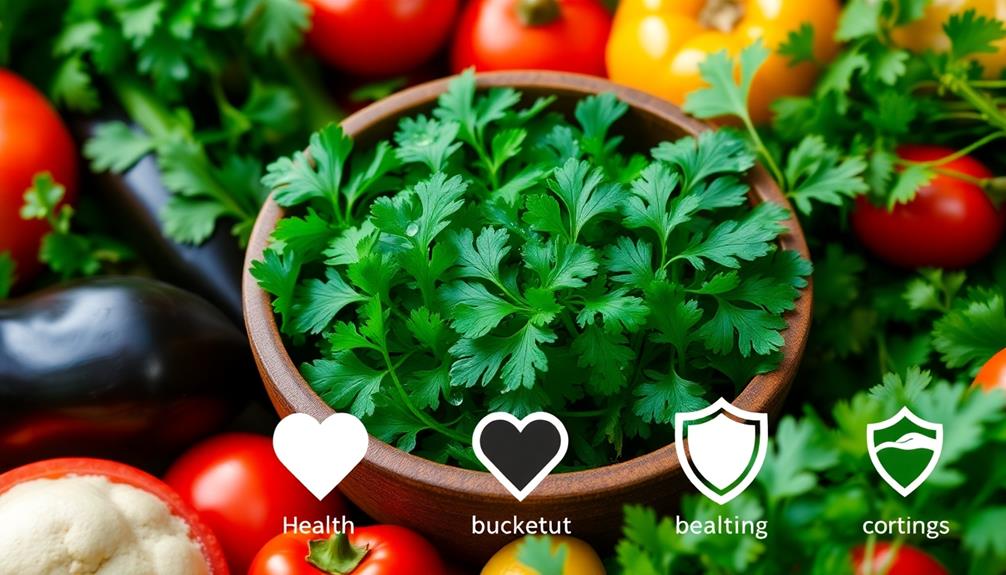
This versatile herb not only adds a burst of flavor to your dishes but also boasts impressive health benefits. Cilantro is recognized for its antimicrobial and antioxidant properties, which can enhance your overall health. One key component, dodecanal, exhibits antibacterial effects against harmful pathogens like salmonella, making cilantro a smart addition to your meals.
Additionally, fresh herbs like cilantro can elevate the flavors in seasonal dishes such as Nettle and Potato Soup, offering both taste and nutrition.
Moreover, cilantro serves as a dietary source of essential minerals such as iron, magnesium, and manganese. These minerals are crucial for various bodily functions, helping to keep you feeling your best. If you struggle with conditions like gout or osteoarthritis, cilantro might be worth considering; some studies suggest it may help reduce uric acid levels.
Additionally, cilantro has been explored for its anti-inflammatory effects, indicating potential support for managing inflammatory conditions.
Flavor Perception and Experience
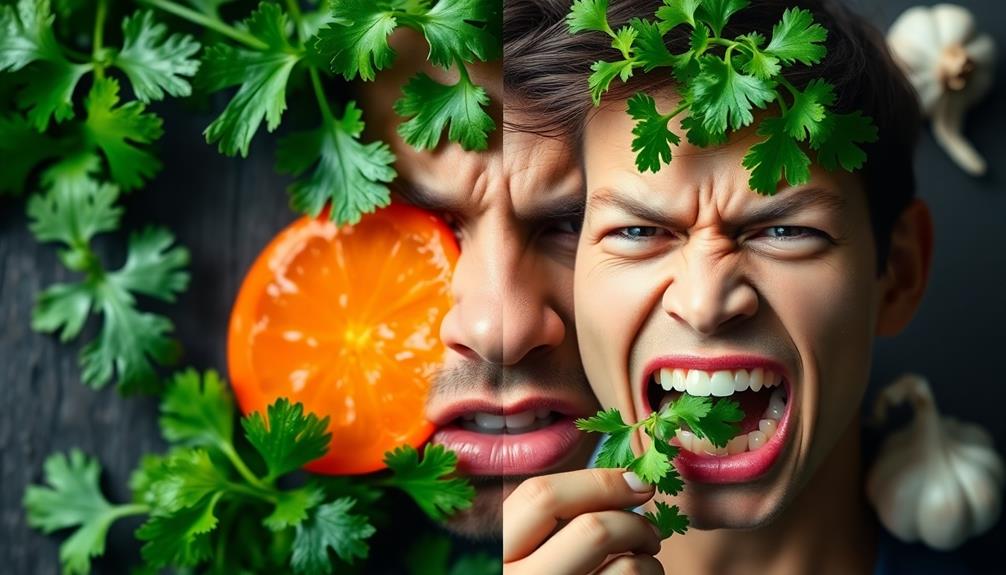
When it comes to cilantro, your experience of its flavor can vary dramatically from person to person. This variation largely stems from the unique aroma and chemical compounds in cilantro, particularly aldehydes, that evoke strong reactions. While you might find its taste fresh and vibrant, others may perceive it as soapy or even rotten.
Genetic factors, especially variations in the OR6A2 gene, play an essential role in this flavor perception; certain alleles heighten sensitivity to those unpleasant notes. Research indicates that between 4% and 14% of people dislike cilantro, with geographic and ethnic differences influencing these aversions—nearly 20% of East Asians report disliking it.
Interestingly, culinary traditions, such as the use of Umeboshi in rice dishes, can also shape one's palate, highlighting how cultural context affects flavor preferences.
In addition, how you prepare cilantro can also impact your experience. Crushing the leaves before use alters its flavor profile, often reducing the soapy taste thanks to enzymatic changes.
Moreover, positive sensory experiences and cultural exposure can shift your taste preferences over time, suggesting that your culinary context is significant in shaping how you perceive cilantro's flavor.
Broader Implications of Taste Preferences
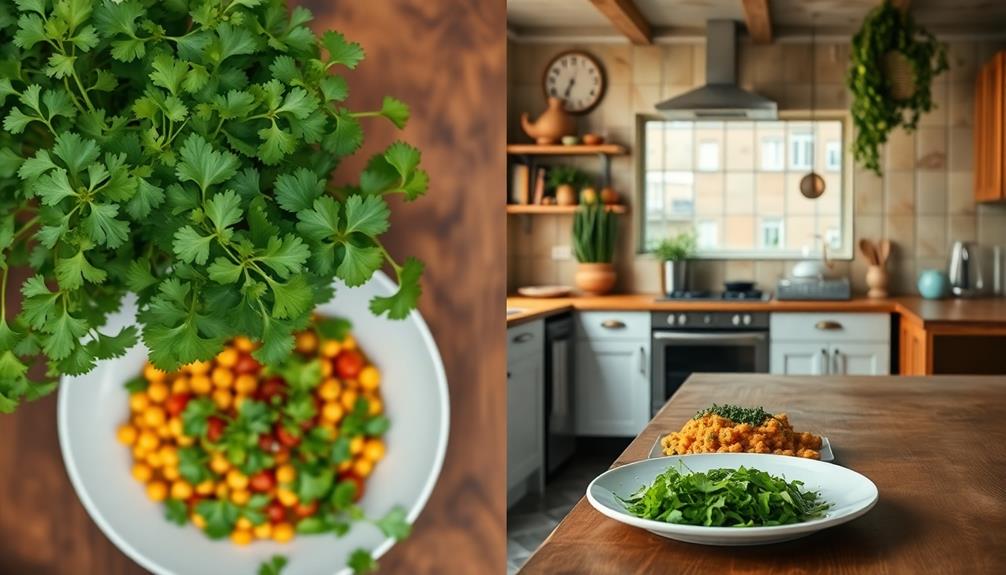
Your taste preferences aren't just random; they're shaped by a mix of genetics, culture, and your environment.
For instance, just as some people are drawn to the rich, sweet flavors of traditional Thai desserts like Khanom Tan, others may have aversions to certain herbs like cilantro due to genetic factors.
The specific gene that makes cilantro taste soapy to some of you highlights how deeply your biology influences what you enjoy eating.
Plus, the cultural context and shared meals in your life can greatly alter how you perceive flavors, making taste a complex interplay of personal and social factors. For example, the psychology of buffet dining suggests that the variety and abundance of options can actually influence our perception of taste, leading us to enjoy the food more. Additionally, the social dynamics at play during a meal can also impact our overall experience of taste, as sharing a meal with loved ones can evoke positive emotions and contribute to a more enjoyable dining experience. In this way, taste is not just a matter of individual preference, but also a result of our cultural and social contexts.
Genetic Influences on Taste
Genetic influences on taste can really shape how you experience certain foods, like cilantro. Your genetic differences play a vital role in whether you perceive its flavor as invigorating or soapy. This variation largely stems from the OR6A2 gene, responsible for detecting specific aldehyde compounds in cilantro.
About 10% of people have heightened sensitivity to these compounds, leading to a strong aversion to cilantro. Curiously, this phenomenon can also be observed in other culinary preferences, such as the love or dislike of flavors found in traditional Mexican dishes.
Studies show that identical twins are more likely to share cilantro preferences, while fraternal twins often don't. This pattern highlights how genetics greatly impacts taste perception.
Additionally, ethnic and geographic factors can further influence your cilantro preferences. For example, nearly 20% of East Asians report disliking cilantro, compared to just 3% of South Asians and Latin Americans.
Understanding these genetic influences on taste can help you make informed dietary choices and appreciate why certain flavors resonate with you while others don't. By recognizing that your taste preferences are partly rooted in your genetics, you can better navigate your food experiences and perhaps even find new flavors you enjoy.
Cultural Impact on Preferences
Cultural familiarity with cilantro plays an essential role in shaping your taste preferences, often determining whether you embrace or reject its distinct flavor. If you grew up in a household where cilantro was a staple, you're likely to enjoy its invigorating notes. In contrast, those raised in cultures where cilantro is less common may experience cilantro aversion.
Culinary traditions from regions where herbs play a significant role, such as in Pasta Alla Norma, showcase how flavor profiles can vary widely based on cultural influences.
Consider how cultural practices influence your palate:
- Different ethnic groups show varying levels of cilantro aversion—21% of East Asians dislike it compared to only 3% of South Asians and Latin Americans.
- Regions like Central America and India celebrate cilantro, leading to lower rates of aversion.
- Social dining experiences often introduce you to cilantro in a positive light, helping to shift your perception over time.
- Conversations surrounding cilantro preferences reveal personal biases influenced by your cultural background.
These factors illustrate how the intersection of genetics and cultural upbringing shapes not only your food choices but also the broader culinary landscape.
Embracing or rejecting cilantro mightn't just be about taste; it's a reflection of your cultural identity and experiences.
Environmental Factors in Aversion
Environmental factors play an essential role in shaping how you perceive cilantro, often transforming aversion into appreciation. When you're repeatedly exposed to cilantro in enjoyable culinary contexts, your feelings about it may shift over time.
Sharing meals that feature cilantro with friends or family can create positive sensory experiences, altering your perception and fostering a newfound preference for the herb.
Interestingly, how you prepare cilantro also matters. Crushing the leaves before use can reduce the soapy taste some people detect, thanks to enzymatic reactions that change its flavor profile. This simple step might make a considerable difference in your enjoyment of cilantro-based dishes.
Additionally, cultural cuisine familiarity considerably impacts flavor acceptance. If you come from a culture where cilantro is a staple, you're likely to embrace its taste rather than recoil from it.
Social dining experiences can further highlight these differences in flavor perception, showcasing how environmental factors shape individual taste preferences.
Ultimately, your environment, including the people you share meals with and the culinary practices you adopt, can help redefine your relationship with cilantro, turning dislike into delight.
Frequently Asked Questions
Why Do Some People Like Cilantro and Others Don't?
Some people enjoy cilantro's fresh flavor, while others find it soapy and off-putting. This difference often stems from genetic factors affecting taste perception, leading to varying reactions to the same herb across individuals.
What Ethnicities Don T Like Cilantro?
You might notice that East Asians and Ashkenazi Jews often dislike cilantro. Europeans follow closely behind, while South Asians, Latin Americans, and Middle Easterners typically embrace it. Familiarity with cilantro shapes these preferences considerably.
Who Should Not Eat Cilantro?
If you have a genetic predisposition to dislike cilantro, allergies, or take anticoagulant medications, it's best to avoid cilantro. Additionally, if you're pregnant or have food sensitivities, consult your healthcare provider first.
What Does Cilantro Do to Some People?
Cilantro can create a curious conundrum for you. If you have certain genetic traits, it might taste soapy and unappetizing. This unique perception can lead to some serious cilantro aversion, mixing flavors and feelings.
Conclusion
In the end, your feelings about cilantro can be as varied as the colors in a painter's palette. Whether you love it or can't stand it, your taste is shaped by genetics, culture, and personal experience. Embracing these differences can lead to richer culinary adventures, so don't shy away from trying new dishes. After all, just like a good recipe, your palate is unique, and that's what makes food exploration so exciting!
